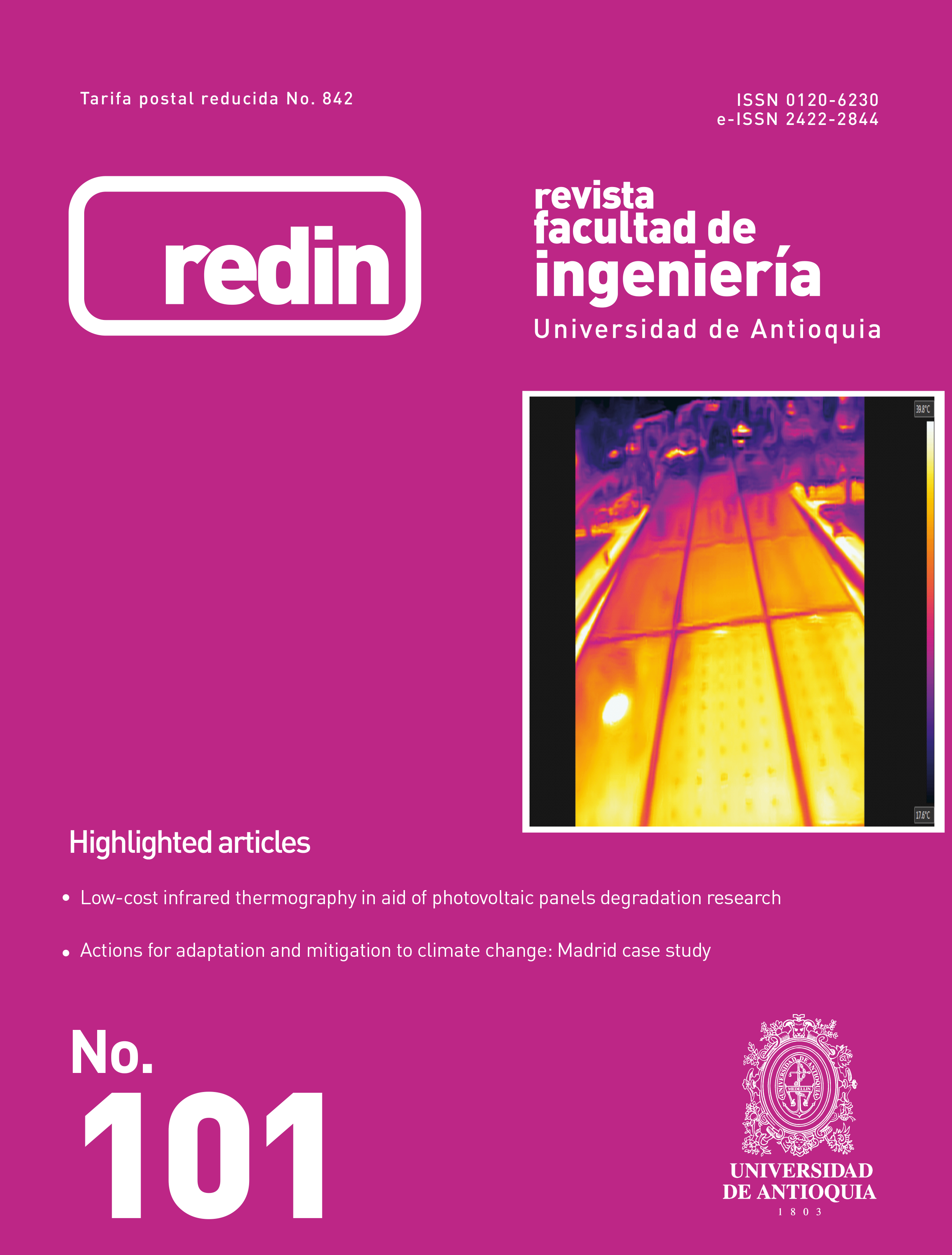Análisis del potencial de ahorro energético para calefacción de fachadas de doble piel vidrio-vidrio
DOI:
https://doi.org/10.17533/udea.redin.20201113Palabras clave:
energía solar, calefacción solar, radiación solar, aire acondicionado, arquitectura bioclimáticaResumen
Se han analizado los flujos de energía de las fachadas de doble piel, vidrio-vidrio, estableciéndose un modelo matemático para determinar el ahorro energético proporcionado por esta solución constructiva en 10 ciudades de España. Se ha encontrado que las dos variables climatológicas que más influyen en el ahorro energético son la temperatura exterior, al estar directamente relacionada con la demanda de calefacción, y la irradiación solar, al ser la fuente de energía de la que se extraen los ahorros. El ahorro energético en invierno varía entre el 11,1 % y el 20,5 % en función de la climatología. Se determinó una relación lineal entre la temperatura exterior media anual y la energía útil aportada por la fachada de doble piel. También se comprobó que el ahorro energético máximo se produce cuando la fachada está desviada unos grados hacia el este respecto a la orientación sur pura. Se desvía más al este cuanto mayor es la temperatura media anual. Se ha establecido una relación lineal entre la temperatura exterior y el azimut de la fachada con el que se produce el ahorro energético máximo. Para obtener porcentajes de ahorro superiores al 20%, la relación entre la superficie de fachada de doble piel y la superficie total calentada del edificio debe ser inferior a 7.
Descargas
Citas
Energy saving and efficiency action plan 2011·2020, Cabinet Meeting Agreement of the Spanish Government, Instituto para la Diversificación y Ahorro de la Energía IDAE, 2011. [Online]. Available: t.ly/vExS
On the energy performance of buildings, Official Journal of the European Union, Directive 2010/31/EU of the european parliament and of the council, 2010. [Online]. Available: t.ly/AKrA
On energy efficiency, amending Directives 2009/125/EC and 2010/30/EU and repealing Directives 2004/8/EC and 2006/32/EC, Official Journal of the European Union, Directive 2012/27/EU of the european parliament and of the council, 2012. [Online]. Available: t.ly/pG1D
Amending Directive 2010/31/EU on the energy performance of buildings and Directive 2012/27/EU on energy efficiency, Official Journal of the European Union, Directive (EU) 2018/844 of the european parliament and of the council, 2018. [Online]. Available: t.ly/Kw7p
F. Pomponia, P. A. E. Piroozfarb, R. Southall, P. Ashton, and E. R. P. Farr, “Energy performance of Double-Skin Façades in temperate climates: A systematic review and meta-analysis,” Renewable and Sustainable Energy Reviews, vol. 54, Feb. 2016. [Online]. Available: https://doi.org/10.1016/j.rser.2015.10.075
A. Ghaffarianhoseini and et al., “Exploring the advantages and challenges of double-skin façades (DSFs),” Renewable and Sustainable Energy Reviews, vol. 60, Jul. 2016. [Online]. Available: https://doi.org/10.1016/j.rser.2016.01.130
F. Pomponi, S. Barbosa, and P. A. E. Piroozfar, “On The Intrinsic Flexibility of the Double Skin Façade: A Comparative Thermal Comfort Investigation in Tropical and Temperate Climates,” Energy Procedia, vol. 111, Mar. 2017. [Online]. Available: https://doi.org/10.1016/j.egypro.2017.03.215
Z. S. Zomorodian and M. Tahsildoost, “Energy and carbon analysis of double skin façades in the hot and dry climate,” Journal of Cleaner Production, vol. 197, Oct. 01 2018. [Online]. Available: https://doi.org/10.1016/j.jclepro.2018.06.178
S. F. Larsen, L. Rengifo, and C. Filippín, “Double skin glazed façades in sunny Mediterranean climates,” Energy and Buildings, vol. 102, Sep. 01 2015. [Online]. Available: https://doi.org/10.1016/j.enbuild.2015.05.019
V. Serra, F. Zanghirella, and M. Perino, “Experimental evaluation of a climate façade: Energy efficiency and thermal comfort performance,” Energy and Buildings, vol. 102, no. 01, Jan. 2010. [Online]. Available: https://doi.org/10.1016/j.enbuild.2009.07.010
L. C. O. Souza, H. A. Souza, and E. F. Rodrigues, “Experimental and numerical analysis of a naturally ventilated double-skin façade,” Energy and Buildings, vol. 165, Apr. 15 2018. [Online]. Available: https://doi.org/10.1016/j.enbuild.2018.01.048
Documentos reconocidos para la Certificación de eficiencia energética de los edificios, Secretaría de Estado de Energía, Gobierno de España, Ministerio para la Transición Ecológica y el Reto Demográfico. [Online]. Available: t.ly/GOwV
Código Técnico de la Edificación CTE, Instituto de Ciencias de la Construcción Eduardo Torroja, Gobierno de España, Ministerio de Transportes, Mobilidad y Agenda Urbana. [Online]. Available: https://www.codigotecnico.org/
Calificación de la eficiencia energética de los edificios, Instituto de Ciencias de la Construcción Eduardo Torroja – IETcc-CSIC y Asociación de Investigación y Cooperación Industrial de Andalucía, AICIA, Gobierno de España, Ministerio de Industria, Energía y Turismo. [Online]. Available: t.ly/k4wB
Descargas
Publicado
Cómo citar
Número
Sección
Licencia
Derechos de autor 2020 Revista Facultad de Ingeniería

Esta obra está bajo una licencia internacional Creative Commons Atribución-NoComercial-CompartirIgual 4.0.
Los artículos disponibles en la Revista Facultad de Ingeniería, Universidad de Antioquia están bajo la licencia Creative Commons Attribution BY-NC-SA 4.0.
Eres libre de:
Compartir — copiar y redistribuir el material en cualquier medio o formato
Adaptar : remezclar, transformar y construir sobre el material.
Bajo los siguientes términos:
Reconocimiento : debe otorgar el crédito correspondiente , proporcionar un enlace a la licencia e indicar si se realizaron cambios . Puede hacerlo de cualquier manera razonable, pero no de ninguna manera que sugiera que el licenciante lo respalda a usted o su uso.
No comercial : no puede utilizar el material con fines comerciales .
Compartir igual : si remezcla, transforma o construye a partir del material, debe distribuir sus contribuciones bajo la misma licencia que el original.
El material publicado por la revista puede ser distribuido, copiado y exhibido por terceros si se dan los respectivos créditos a la revista, sin ningún costo. No se puede obtener ningún beneficio comercial y las obras derivadas tienen que estar bajo los mismos términos de licencia que el trabajo original.










 Twitter
Twitter